Bioinspired Interfacial Friction Control: From Chemistry to Structures to Mechanics
Abstract
:1. Introduction
2. Surface Chemistry-Dominated Friction
3. Surface Structure-Dominated Friction

4. Mechanics-Dominated Friction
5. Multiple Strategies Coupling-Dominated Friction
5.1. Surface Chemistry Coupling Structure
5.2. Surface Chemistry Coupling Mechanics
5.3. Simultaneous Coupling of Three Strategies
6. Summary and Perspective
Author Contributions
Funding
Data Availability Statement
Conflicts of Interest
References
- Li, X.; Guo, Z.; Huang, Q.; Yuan, C. Application of Bionic Tribology in Water-Lubricated Bearing: A Review. J. Bionic Eng. 2022, 19, 902–934. [Google Scholar] [CrossRef]
- Coles, J.M.; Chang, D.P.; Zauscher, S. Molecular Mechanisms of Aqueous Boundary Lubrication by Mucinous Glycoproteins. Curr. Opin. Colloid Interface Sci. 2010, 15, 406–416. [Google Scholar] [CrossRef]
- Autumn, K.; Liang, Y.A.; Hsieh, S.T.; Zesch, W.; Chan, W.P.; Kenny, T.W.; Fearing, R.; Full, R.J. Adhesive Force of a Single Gecko Foot-Hair. Nature 2000, 405, 681–685. [Google Scholar] [CrossRef] [PubMed]
- Zhang, D.; Luo, Y.; Li, X.; Chen, H. Numerical Simulation and Experimental Study of Drag-Reducing Surface of a Real Shark Skin. J. Hydrodyn. 2011, 23, 204–211. [Google Scholar] [CrossRef]
- Wilkie, I.C. Is Muscle Involved in the Mechanical Adaptability of Echinoderm Mutable Collagenous Tissue? J. Exp. Biol. 2002, 205 Pt 2, 159–165. [Google Scholar] [CrossRef] [PubMed]
- Jusufi, A.; Vogt, D.M.; Wood, R.J.; Lauder, G.V. Undulatory Swimming Performance and Body Stiffness Modulation in a Soft Robotic Fish-Inspired Physical Model. Soft Robot. 2017, 4, 202–210. [Google Scholar] [CrossRef] [PubMed]
- Klein, J. Hydration Lubrication. Friction 2013, 1, 1–23. [Google Scholar] [CrossRef]
- Ma, L.; Gaisinskaya-Kipnis, A.; Kampf, N.; Klein, J. Origins of Hydration Lubrication. Nat. Commun. 2015, 6, 6060. [Google Scholar] [CrossRef] [PubMed]
- Raviv, U.; Laurat, P.; Klein, J. Fluidity of Water Confined to Subnanometre Films. Nature 2001, 413, 51–54. [Google Scholar] [CrossRef]
- Pashley, R.M. Hydration Forces between Mica Surfaces in Aqueous Electrolyte Solutions. J. Colloid Interface Sci. 1981, 80, 153–162. [Google Scholar] [CrossRef]
- Lane, J.M.D.; Chandross, M.; Stevens, M.J.; Grest, G.S. Water in Nanoconfinement between Hydrophilic Self-Assembled Monolayers. Langmuir 2008, 24, 5209–5212. [Google Scholar] [CrossRef] [PubMed]
- Xu, J.; Luo, J.B.; Liu, S.H.; Xie, G.X.; Ma, L. Tribological Characteristics of Aloe Mucilage. Tribol. –Mater. Surf. Interfaces 2008, 2, 72–76. [Google Scholar] [CrossRef]
- Hakala, T.J.; Saikko, V.; Arola, S.; Ahlroos, T.; Helle, A.; Kuosmanen, P.; Holmberg, K.; Linder, M.B.; Laaksonen, P. Structural Characterization and Tribological Evaluation of Quince Seed Mucilage. Tribol. Int. 2014, 77, 24–31. [Google Scholar] [CrossRef]
- Arad, S.; Rapoport, L.; Moshkovich, A.; Van Moppes, D.; Karpasas, M.; Golan, R.; Golan, Y. Superior Biolubricant from a Species of Red Microalga. Langmuir 2006, 22, 7313–7317. [Google Scholar] [CrossRef] [PubMed]
- Li, J.; Liu, Y.; Luo, J.; Liu, P.; Zhang, C. Excellent Lubricating Behavior of Brasenia Schreberi Mucilage. Langmuir 2012, 28, 7797–7802. [Google Scholar] [CrossRef] [PubMed]
- Pult, H.; Tosatti, S.G.P.; Spencer, N.D.; Asfour, J.-M.; Ebenhoch, M.; Murphy, P.J. Spontaneous Blinking from a Tribological Viewpoint. Ocul. Surf. 2015, 13, 236–249. [Google Scholar] [CrossRef] [PubMed]
- Lin, C.X.; Li, W.; Deng, H.Y.; Li, K.; Zhou, Z.R. Friction Behavior of Esophageal Mucosa Under Axial and Circumferential Extension. Tribol. Lett. 2019, 67, 9. [Google Scholar] [CrossRef]
- Veeregowda, D.H.; Busscher, H.J.; Vissink, A.; Jager, D.-J.; Sharma, P.K.; Van Der Mei, H.C. Role of Structure and Glycosylation of Adsorbed Protein Films in Biolubrication. PLoS ONE 2012, 7, e42600. [Google Scholar] [CrossRef] [PubMed]
- Cleather, D.J.; Goodwin, J.E.; Bull, A.M.J. Hip and Knee Joint Loading during Vertical Jumping and Push Jerking. Clin. Biomech. 2013, 28, 98–103. [Google Scholar] [CrossRef]
- Gong, J.P. Friction and Lubrication of Hydrogels—Its Richness and Complexity. Soft Matter 2006, 2, 544–552. [Google Scholar] [CrossRef]
- Klein, J. Repair or Replacement--A Joint Perspective. Science 2009, 323, 47–48. [Google Scholar] [CrossRef] [PubMed]
- Xue, F.; Zhang, H.; Hu, J.; Liu, Y. Hyaluronic Acid Nanofibers Crosslinked with a Nontoxic Reagent. Carbohydr. Polym. 2021, 259, 117757. [Google Scholar] [CrossRef] [PubMed]
- Bełdowski, P.; Yuvan, S.; Dėdinaitė, A.; Claesson, P.M.; Pöschel, T. Interactions of a Short Hyaluronan Chain with a Phospholipid Membrane. Colloids Surf. B Biointerfaces 2019, 184, 110539. [Google Scholar] [CrossRef] [PubMed]
- Klein, J.; Kumacheva, E.; Mahalu, D.; Perahia, D.; Fetters, L.J. Reduction of Frictional Forces between Solid Surfaces Bearing Polymer Brushes. Nature 1994, 370, 634–636. [Google Scholar] [CrossRef]
- Tadmor, R.; Janik, J.; Klein, J.; Fetters, L.J. Sliding Friction with Polymer Brushes. Phys. Rev. Lett. 2003, 91, 115503. [Google Scholar] [CrossRef] [PubMed]
- Kobayashi, M.; Takahara, A. Tribological Properties of Hydrophilic Polymer Brushes under Wet Conditions. Chem. Rec. 2010, 10, 208–216. [Google Scholar] [CrossRef]
- Jahn, S.; Klein, J. Hydration Lubrication: The Macromolecular Domain. Macromolecules 2015, 48, 5059–5075. [Google Scholar] [CrossRef]
- De Beer, S.; Kenmoé, G.D.; Müser, M.H. On the Friction and Adhesion Hysteresis between Polymer Brushes Attached to Curved Surfaces: Rate and Solvation Effects. Friction 2015, 3, 148–160. [Google Scholar] [CrossRef]
- Vandeweerd, J.-M.; Innocenti, B.; Rocasalbas, G.; Gautier, S.E.; Douette, P.; Hermitte, L.; Hontoir, F.; Chausson, M. Non-Clinical Assessment of Lubrication and Free Radical Scavenging of an Innovative Non-Animal Carboxymethyl Chitosan Biomaterial for Viscosupplementation: An in-Vitro and Ex-Vivo Study. PLoS ONE 2021, 16, e0256770. [Google Scholar] [CrossRef]
- Bauerova, K.; Ponist, S.; Kuncirova, V.; Mihalova, D.; Paulovicova, E.; Volpi, N. Chondroitin Sulfate Effect on Induced Arthritis in Rats. Osteoarthr. Cartil. 2011, 19, 1373–1379. [Google Scholar] [CrossRef]
- Sawitzke, A.D.; Shi, H.; Finco, M.F.; Dunlop, D.D.; Bingham III, C.O.; Harris, C.L.; Singer, N.G.; Bradley, J.D.; Silver, D.; Jackson, C.G.; et al. The Effect of Glucosamine and/or Chondroitin Sulfate on the Progression of Knee Osteoarthritis: A Report from the Glucosamine/Chondroitin Arthritis Intervention Trial. Arthritis Rheum. 2008, 58, 3183–3191. [Google Scholar] [CrossRef] [PubMed]
- Wathier, M.; Lakin, B.A.; Bansal, P.N.; Stoddart, S.S.; Snyder, B.D.; Grinstaff, M.W. A Large-Molecular-Weight Polyanion, Synthesized via Ring-Opening Metathesis Polymerization, as a Lubricant for Human Articular Cartilage. J. Am. Chem. Soc. 2013, 135, 4930–4933. [Google Scholar] [CrossRef] [PubMed]
- Hartung, W.; Drobek, T.; Lee, S.; Zürcher, S.; Spencer, N.D. The Influence of Anchoring-Group Structure on the Lubricating Properties of Brush-Forming Graft Copolymers in an Aqueous Medium. Tribol. Lett. 2008, 31, 119–128. [Google Scholar] [CrossRef]
- Perry, S.S.; Yan, X.; Limpoco, F.T.; Lee, S.; Müller, M.; Spencer, N.D. Tribological Properties of Poly(l-Lysine)-Graft-Poly(Ethylene Glycol) Films: Influence of Polymer Architecture and Adsorbed Conformation. ACS Appl. Mater. Interfaces 2009, 1, 1224–1230. [Google Scholar] [CrossRef] [PubMed]
- Hartung, W.; Rossi, A.; Lee, S.; Spencer, N.D. Aqueous Lubrication of SiC and Si3N4 Ceramics Aided by a Brush-like Copolymer Additive, Poly(l-Lysine)-Graft-Poly(Ethylene Glycol). Tribol. Lett. 2009, 34, 201–210. [Google Scholar] [CrossRef]
- Pettersson, T.; Naderi, A.; Makuška, R.; Claesson, P.M. Lubrication Properties of Bottle-Brush Polyelectrolytes: An AFM Study on the Effect of Side Chain and Charge Density. Langmuir 2008, 24, 3336–3347. [Google Scholar] [CrossRef] [PubMed]
- Crockett, R. Boundary Lubrication in Natural Articular Joints. Tribol. Lett. 2009, 35, 77–84. [Google Scholar] [CrossRef]
- Raviv, U.; Giasson, S.; Kampf, N.; Gohy, J.-F.; Jérôme, R.; Klein, J. Lubrication by Charged Polymers. Nature 2003, 425, 163–165. [Google Scholar] [CrossRef] [PubMed]
- Zhao, B.; Brittain, W.J. Polymer Brushes: Surface-Immobilized Macromolecules. Prog. Polym. Sci. 2000, 25, 677–710. [Google Scholar] [CrossRef]
- Cai, Z.; Zhang, H.; Wei, Y.; Wu, M.; Fu, A. Shear-Thinning Hyaluronan-Based Fluid Hydrogels to Modulate Viscoelastic Properties of Osteoarthritis Synovial Fluids. Biomater. Sci. 2019, 7, 3143–3157. [Google Scholar] [CrossRef]
- Lin, W.; Mashiah, R.; Seror, J.; Kadar, A.; Dolkart, O.; Pritsch, T.; Goldberg, R.; Klein, J. Lipid-Hyaluronan Synergy Strongly Reduces Intrasynovial Tissue Boundary Friction. Acta Biomater. 2019, 83, 314–321. [Google Scholar] [CrossRef] [PubMed]
- Momose, T.; Amadio, P.C.; Sun, Y.-L.; Zhao, C.; Zobitz, M.E.; Harrington, J.R.; An, K.-N. Surface Modification of Extrasynovial Tendon by Chemically Modified Hyaluronic Acid Coating. J. Biomed. Mater. Res. 2002, 59, 219–224. [Google Scholar] [CrossRef] [PubMed]
- Xu, R.; Ma, S.; Wu, Y.; Lee, H.; Zhou, F.; Liu, W. Adaptive Control in Lubrication, Adhesion, and Hemostasis by Chitosan–Catechol–pNIPAM. Biomater. Sci. 2019, 7, 3599–3608. [Google Scholar] [CrossRef] [PubMed]
- Valle-Delgado, J.J.; Johansson, L.-S.; Österberg, M. Bioinspired Lubricating Films of Cellulose Nanofibrils and Hyaluronic Acid. Colloids Surf. B Biointerfaces 2016, 138, 86–93. [Google Scholar] [CrossRef] [PubMed]
- Røn, T.; Javakhishvili, I.; Hvilsted, S.; Jankova, K.; Lee, S. Ultralow Friction with Hydrophilic Polymer Brushes in Water as Segregated from Silicone Matrix. Adv. Mater. Interfaces 2016, 3, 1500472. [Google Scholar] [CrossRef]
- Gaisinskaya-Kipnis, A.; Jahn, S.; Goldberg, R.; Klein, J. Effect of Glucosamine Sulfate on Surface Interactions and Lubrication by Hydrogenated Soy Phosphatidylcholine (HSPC) Liposomes. Biomacromolecules 2014, 15, 4178–4186. [Google Scholar] [CrossRef] [PubMed]
- Wang, M.; Zander, T.; Liu, X.; Liu, C.; Raj, A.; Florian Wieland, D.C.; Garamus, V.M.; Willumeit-Römer, R.; Claesson, P.M.; Dėdinaitė, A. The Effect of Temperature on Supported Dipalmitoylphosphatidylcholine (DPPC) Bilayers: Structure and Lubrication Performance. J. Colloid Interface Sci. 2015, 445, 84–92. [Google Scholar] [CrossRef] [PubMed]
- Duan, Y.; Liu, Y.; Zhang, C.; Chen, Z.; Wen, S. Insight into the Tribological Behavior of Liposomes in Artificial Joints. Langmuir 2016, 32, 10957–10966. [Google Scholar] [CrossRef]
- Adibnia, V.; Mirbagheri, M.; Faivre, J.; Robert, J.; Lee, J.; Matyjaszewski, K.; Lee, D.W.; Banquy, X. Bioinspired Polymers for Lubrication and Wear Resistance. Prog. Polym. Sci. 2020, 110, 101298. [Google Scholar] [CrossRef]
- Kim, H.S.; Crosby, A.J. Solvent-Responsive Surface via Wrinkling Instability. Adv. Mater. 2011, 23, 4188–4192. [Google Scholar] [CrossRef]
- Wang, D.; Liu, Y.; Liu, X.; Zhou, F.; Liu, W.; Xue, Q. Towards a Tunable and Switchable Water Adhesion on a TiO2nanotube Film with Patterned Wettability. Chem. Commun. 2009, 45, 7018–7020. [Google Scholar] [CrossRef]
- Moon, H.J.; Ko, D.Y.; Park, M.H.; Joo, M.K.; Jeong, B. Temperature-Responsive Compounds as in Situ Gelling Biomedical Materials. Chem. Soc. Rev. 2012, 41, 4860–4883. [Google Scholar] [CrossRef] [PubMed]
- Yu, X.; Wang, Z.; Jiang, Y.; Shi, F.; Zhang, X. Reversible pH-Responsive Surface: From Superhydrophobicity to Superhydrophilicity. Adv. Mater. 2005, 17, 1289–1293. [Google Scholar] [CrossRef]
- Lahann, J.; Mitragotri, S.; Tran, T.-N.; Kaido, H.; Sundaram, J.; Choi, I.S.; Hoffer, S.; Somorjai, G.A.; Langer, R. A Reversibly Switching Surface. Science 2003, 299, 371–374. [Google Scholar] [CrossRef] [PubMed]
- Zhang, X.; Shi, K.; Yang, X.; Wang, J.; Liu, H.; Song, W.; Wang, S. Supramolecular Semi-Convertible Hydrogel Enabled Self-Healing Responsive Lubrication under Dynamic Shearing. CCS Chem. 2023, 5, 2482–2496. [Google Scholar] [CrossRef]
- Wu, Y.; Pei, X.; Wang, X.; Liang, Y.; Liu, W.; Zhou, F. Biomimicking Lubrication Superior to Fish Skin Using Responsive Hydrogels. NPG Asia Mater 2014, 6, e136. [Google Scholar] [CrossRef]
- Wang, J.; Zhang, X.; Zhang, S.; Kang, J.; Guo, Z.; Feng, B.; Zhao, H.; Luo, Z.; Yu, J.; Song, W.; et al. Semi-Convertible Hydrogel Enabled Photoresponsive Lubrication. Matter 2021, 4, 675–687. [Google Scholar] [CrossRef]
- Deng, S.; Wu, L.; Lai, J.; Wang, L.; Yan, G.; Zhao, C.; Xiang, D.; Li, H.; Wang, B.; Li, Z.; et al. Bioinspired Ultra-Lubrication Hydrogels with Controllably Switchable Lubrication. Colloids Surf. A Physicochem. Eng. Asp. 2023, 675, 132033. [Google Scholar] [CrossRef]
- Willis, E. Surface Finish in Relation to Cylinder Liners. Wear 1986, 109, 351–366. [Google Scholar] [CrossRef]
- Etsion, I. State of the Art in Laser Surface Texturing. J. Tribol. 2005, 127, 248–253. [Google Scholar] [CrossRef]
- Lu, Y. Superior Lubrication Properties of Biomimetic Surfaces with Hierarchical Structure. Tribol. Int. 2018, 119, 131–142. [Google Scholar] [CrossRef]
- Li, X.; Deng, J.; Yue, H.; Ge, D.; Zou, X. Wear Performance of Electrohydrodynamically Atomized WS2 Coatings Deposited on Biomimetic Shark-Skin Textured Surfaces. Tribol. Int. 2019, 134, 240–251. [Google Scholar] [CrossRef]
- Hazel, J.; Stone, M.; Grace, M.S.; Tsukruk, V.V. Nanoscale Design of Snake Skin for Reptation Locomotions via Friction Anisotropy. J. Biomech. 1999, 32, 477–484. [Google Scholar] [CrossRef] [PubMed]
- Su, Y.; Ji, B.; Zhang, K.; Gao, H.; Huang, Y.; Hwang, K. Nano to Micro Structural Hierarchy Is Crucial for Stable Superhydrophobic and Water-Repellent Surfaces. Langmuir 2010, 26, 4984–4989. [Google Scholar] [CrossRef] [PubMed]
- Gogolides, E.; Ellinas, K.; Tserepi, A. Hierarchical Micro and Nano Structured, Hydrophilic, Superhydrophobic and Superoleophobic Surfaces Incorporated in Microfluidics, Microarrays and Lab on Chip Microsystems. Microelectron. Eng. 2015, 132, 135–155. [Google Scholar] [CrossRef]
- Burton, Z.; Bhushan, B. Hydrophobicity, Adhesion, and Friction Properties of Nanopatterned Polymers and Scale Dependence for Micro- and Nanoelectromechanical Systems. Nano Lett. 2005, 5, 1607–1613. [Google Scholar] [CrossRef] [PubMed]
- Bidkar, R.A.; Leblanc, L.; Kulkarni, A.J.; Bahadur, V.; Ceccio, S.L.; Perlin, M. Skin-Friction Drag Reduction in the Turbulent Regime Using Random-Textured Hydrophobic Surfaces. Phys. Fluids 2014, 26, 085108. [Google Scholar] [CrossRef]
- Gao, N.; Yan, Y.Y.; Chen, X.Y.; Mee, D.J. Superhydrophobic Surfaces with Hierarchical Structure. Mater. Lett. 2011, 65, 2902–2905. [Google Scholar] [CrossRef]
- Qin, L.; Wu, Y.; Ma, Z.; Li, H.; Lu, S.; Wang, Z.; Liu, J.; Dong, M.; Zhang, Y. Fluorine-Free and Highly Durable Superhydrophobic Textiles for Antifouling and Anti-Icing Applications. ACS Appl. Polym. Mater. 2023, 5, 6278–6287. [Google Scholar] [CrossRef]
- Zhang, X.; Guo, Y.; Zhang, Z.; Zhang, P. Self-Cleaning Superhydrophobic Surface Based on Titanium Dioxide Nanowires Combined with Polydimethylsiloxane. Appl. Surf. Sci. 2013, 284, 319–323. [Google Scholar] [CrossRef]
- Dalawai, S.P.; Saad Aly, M.A.; Latthe, S.S.; Xing, R.; Sutar, R.S.; Nagappan, S.; Ha, C.-S.; Kumar Sadasivuni, K.; Liu, S. Recent Advances in Durability of Superhydrophobic Self-Cleaning Technology: A Critical Review. Prog. Org. Coat. 2020, 138, 105381. [Google Scholar] [CrossRef]
- Bechert, D.W.; Bruse, M.; Hage, W. Experiments with Three-Dimensional Riblets as an Idealized Model of Shark Skin. Exp. Fluids 2000, 28, 403–412. [Google Scholar] [CrossRef]
- Bechert, D.W.; Bartenwerfer, M. The Viscous Flow on Surfaces with Longitudinal Ribs. J. Fluid Mech. 1989, 206, 105–129. [Google Scholar] [CrossRef]
- Bechert, D.W.; Bruse, M.; Hage, W.; Hoeven, J.G.T.V.D.; Hoppe, G. Experiments on Drag-Reducing Surfaces and Their Optimization with an Adjustable Geometry. J. Fluid Mech. 1997, 338, 59–87. [Google Scholar] [CrossRef]
- Xing, Y.; Zhu, M.; Wu, Z.; Li, Z.; Bai, S.; Zhang, K.; Liu, L. High-Temperature Tribological Properties of Si3N4/TiC Ceramic with Bionic Surface Textures and DLC Coatings. Tribol. Int. 2023, 186, 108648. [Google Scholar] [CrossRef]
- Qin, L.; Huang, X.; Sun, Z.; Ma, Z.; Mawignon, F.J.; Lv, B.; Shan, L.; Dong, G. Synergistic Effect of Sharkskin-Inspired Morphologies and Surface Chemistry on Regulating Stick-Slip Friction. Tribol. Int. 2023, 187, 108765. [Google Scholar] [CrossRef]
- Ghimire, A.; Dahl, R.B.; Shen, S.; Chen, P. Shark Skin Denticles: From Morphological Diversity to Multi-functional Adaptations and Applications. Adv. Funct. Mater. 2024, 2307121. [Google Scholar] [CrossRef]
- Abdel-Aal, H.A. On Surface Structure and Friction Regulation in Reptilian Limbless Locomotion. J. Mech. Behav. Biomed. Mater. 2013, 22, 115–135. [Google Scholar] [CrossRef] [PubMed]
- Benz, M.J.; Kovalev, A.E.; Gorb, S.N. Anisotropic Frictional Properties in Snakes. In Bioinspiration, Biomimetics, and Bioreplication 2012; SPIE: Bellingham, WA, USA, 2012; Volume 8339, pp. 256–261. [Google Scholar] [CrossRef]
- Baum, M.J.; Kovalev, A.E.; Michels, J.; Gorb, S.N. Anisotropic Friction of the Ventral Scales in the Snake Lampropeltis Getula Californiae. Tribol. Lett. 2014, 54, 139–150. [Google Scholar] [CrossRef]
- Saito, Y.; Yabu, H. Bio-Inspired Low Frictional Surfaces Having Micro-Dimple Arrays Prepared with Honeycomb Patterned Porous Films as Wet Etching Masks. Langmuir 2015, 31, 959–963. [Google Scholar] [CrossRef]
- Ballesteros, L.M.; Zuluaga, E.; Cuervo, P.; Rudas, J.S.; Toro, A. Tribological Behavior of Polymeric 3D-Printed Surfaces with Deterministic Patterns Inspired in Snake Skin Morphology. Surf. Topogr.-Metrol. Prop. 2021, 9, 014002. [Google Scholar] [CrossRef]
- Zhao, J.; Ji, K.; Chen, Q.; Khan, M.N.; Tu, C.; Ma, Z.; Wu, J.; Chen, J.; Dai, Z. Resistance Reduction of Patterned Surface Inspired by Cuticle Structure of Achalinus Spinalis. Friction 2023, 11, 1359–1370. [Google Scholar] [CrossRef]
- Zhao, Y.; Mei, H.; Chang, P.; Yang, Y.; Cheng, L.; Zhang, L. High-Strength Printed Ceramic Structures for Higher Temperature Lubrication. Compos. Part B Eng. 2021, 221, 109013. [Google Scholar] [CrossRef]
- Patankar, N.A. Mimicking the Lotus Effect: Influence of Double Roughness Structures and Slender Pillars. Langmuir 2004, 20, 8209–8213. [Google Scholar] [CrossRef] [PubMed]
- Jung, Y.C.; Bhushan, B. Biomimetic Structures for Fluid Drag Reduction in Laminar and Turbulent Flows. J. Phys.-Condens. Matter 2010, 22, 035104. [Google Scholar] [CrossRef] [PubMed]
- You, C.; Zhao, G.; Chu, X.; Zhou, W.; Long, Y.; Lian, Y. Design, Preparation and Cutting Performance of Bionic Cutting Tools Based on Head Microstructures of Dung Beetle. J. Manuf. Process. 2020, 58, 129–135. [Google Scholar] [CrossRef]
- Xu, X.; Wu, J.; Yang, Y.; Zhu, R.; Yan, S. Operculum of a Water Snail Is a Hydrodynamic Lubrication Sheet. J. Bionic Eng. 2018, 15, 471–480. [Google Scholar] [CrossRef]
- Bixler, G.D.; Bhushan, B. Bioinspired Rice Leaf and Butterfly Wing Surface Structures Combining Shark Skin and Lotus Effects. Soft Matter 2012, 8, 11271. [Google Scholar] [CrossRef]
- Radhakrishnan, V. Locomotion: Dealing with Friction. Proc. Natl. Acad. Sci. USA 1998, 95, 5448–5455. [Google Scholar] [CrossRef]
- Dickinson, M.H.; Farley, C.T.; Full, R.J.; Koehl, M.A.R.; Kram, R.; Lehman, S. How Animals Move: An Integrative View. Science 2000, 288, 100–106. [Google Scholar] [CrossRef]
- Ming, X.; Yao, L.; Zhu, H.; Zhang, Q.; Zhu, S. Dramatic and Reversible Water-Induced Stiffening Driven by Phase Separation within Polymer Gels. Adv. Funct. Mater. 2022, 32, 2109850. [Google Scholar] [CrossRef]
- Zhang, Y.; Zhao, W.; Ma, S.; Liu, H.; Wang, X.; Zhao, X.; Yu, B.; Cai, M.; Zhou, F. Modulus Adaptive Lubricating Prototype Inspired by Instant Muscle Hardening Mechanism of Catfish Skin. Nat. Commun. 2022, 13, 377. [Google Scholar] [CrossRef] [PubMed]
- Popov, V.L. Contact Mechanics and Friction; Springer: Berlin/Heidelberg, Germany, 2010. [Google Scholar] [CrossRef]
- Kwiatkowska, M.; Franklin, S.E.; Hendriks, C.P.; Kwiatkowski, K. Friction and Deformation Behaviour of Human Skin. Wear 2009, 267, 1264–1273. [Google Scholar] [CrossRef]
- Mahdi, D.; Riches, A.; Gester, M.; Yeomans, J.; Smith, P. Rolling and Sliding: Separation of Adhesion and Deformation Friction and Their Relative Contribution to Total Friction. Tribol. Int. 2015, 89, 128–134. [Google Scholar] [CrossRef]
- Ge, Z.; Li, C.; Heng, B.C.; Cao, G.; Yang, Z. Functional Biomaterials for Cartilage Regeneration. J. Biomed. Mater. Res. Part A 2012, 100A, 2526–2536. [Google Scholar] [CrossRef] [PubMed]
- Zhao, Z.; Fang, R.; Rong, Q.; Liu, M. Bioinspired Nanocomposite Hydrogels with Highly Ordered Structures. Adv. Mater. 2017, 29, 1703045. [Google Scholar] [CrossRef] [PubMed]
- Buckner, T.L.; Yuen, M.C.; Kim, S.Y.; Kramer-Bottiglio, R. Enhanced Variable Stiffness and Variable Stretchability Enabled by Phase-Changing Particulate Additives. Adv. Funct. Mater. 2019, 29, 1903368. [Google Scholar] [CrossRef]
- Sharifi, S.; Rux, C.; Sparling, N.; Wan, G.; Mohammadi Nasab, A.; Siddaiah, A.; Menezes, P.; Zhang, T.; Shan, W. Dynamically Tunable Friction via Subsurface Stiffness Modulation. Front. Robot. AI 2021, 8, 691789. [Google Scholar] [CrossRef]
- Liu, Y.; Wang, Y.; Yang, X.; Huang, W.; Zhang, Y.; Zhang, X.; Wang, X. Stiffness Variable Polymer for Soft Actuators with Sharp Stiffness Switch and Fast Response. ACS Appl. Mater. Interfaces 2023, 15, 26016–26027. [Google Scholar] [CrossRef]
- Bohn, H.F.; Federle, W. Insect Aquaplaning: Nepenthes Pitcher Plants Capture Prey with the Peristome, a Fully Wettable Water-Lubricated Anisotropic Surface. Proc. Natl. Acad. Sci. USA 2004, 101, 14138–14143. [Google Scholar] [CrossRef]
- Bauer, U.; Federle, W. The Insect-Trapping Rim of Nepenthes Pitchers: Surface Structure and Function. Plant Signal. Behav. 2009, 4, 1019–1023. [Google Scholar] [CrossRef] [PubMed]
- Federle, W.; Riehle, M.; Curtis, A.S.G.; Full, R.J. An Integrative Study of Insect Adhesion: Mechanics and Wet Adhesion of Pretarsal Pads in Ants1. Integr. Comp. Biol. 2002, 42, 1100–1106. [Google Scholar] [CrossRef] [PubMed]
- Wong, T.-S.; Kang, S.H.; Tang, S.K.Y.; Smythe, E.J.; Hatton, B.D.; Grinthal, A.; Aizenberg, J. Bioinspired Self-Repairing Slippery Surfaces with Pressure-Stable Omniphobicity. Nature 2011, 477, 443–447. [Google Scholar] [CrossRef] [PubMed]
- Ma, Q.; Wang, W.; Dong, G. Facile Fabrication of Biomimetic Liquid-Infused Slippery Surface on Carbon Steel and Its Self-Cleaning, Anti-Corrosion, Anti-Frosting and Tribological Properties. Colloids Surf. A Physicochem. Eng. Asp. 2019, 577, 17–26. [Google Scholar] [CrossRef]
- Tong, Z.; Song, L.; Chen, S.; Hu, J.; Hou, Y.; Liu, Q.; Ren, Y.; Zhan, X.; Zhang, Q. Hagfish-Inspired Smart SLIPS Marine Antifouling Coating Based on Supramolecular: Lubrication Modes Responsively Switching and Self-Healing Properties. Adv. Funct. Mater. 2022, 32, 2201290. [Google Scholar] [CrossRef]
- Zhang, D.; Chen, Y.; Ma, Y.; Guo, L.; Sun, J.; Tong, J. Earthworm Epidermal Mucus: Rheological Behavior Reveals Drag-Reducing Characteristics in Soil. Soil Tillage Res. 2016, 158, 57–66. [Google Scholar] [CrossRef]
- Huang, C.; Guo, Z. Fabrications and Applications of Slippery Liquid-Infused Porous Surfaces Inspired from Nature: A Review. J. Bionic Eng. 2019, 16, 769–793. [Google Scholar] [CrossRef]
- Zhao, H.; Sun, Q.; Deng, X.; Cui, J. Earthworm-Inspired Rough Polymer Coatings with Self-Replenishing Lubrication for Adaptive Friction-Reduction and Antifouling Surfaces. Adv. Mater. 2018, 30, 1802141. [Google Scholar] [CrossRef] [PubMed]
- Ruan, H.; Zhang, Y.; Wang, Q.; Wang, C.; Wang, T. A Novel Earthworm-Inspired Smart Lubrication Material with Self-Healing Function. Tribol. Int. 2022, 165, 107303. [Google Scholar] [CrossRef]
- Yang, F.; Zhao, J.; Koshut, W.J.; Watt, J.; Riboh, J.C.; Gall, K.; Wiley, B.J. A Synthetic Hydrogel Composite with the Mechanical Behavior and Durability of Cartilage. Adv. Funct. Mater. 2020, 30, 2003451. [Google Scholar] [CrossRef]
- Sakakibara, K.; Maeda, K.; Yoshikawa, C.; Tsujii, Y. Water Lubricating and Biocompatible Films of Bacterial Cellulose Nanofibers Surface-Modified with Densely Grafted, Concentrated Polymer Brushes. ACS Appl. Nano Mater. 2021, 4, 1503–1511. [Google Scholar] [CrossRef]
- Wei, Z.; He, J.; Liang, T.; Oh, H.; Athas, J.; Tong, Z.; Wang, C.; Nie, Z. Autonomous Self-Healing of Poly(Acrylic Acid) Hydrogels Induced by the Migration of Ferric Ions. Polym. Chem. 2013, 4, 4601–4605. [Google Scholar] [CrossRef]
- Gan, D.; Wang, Z.; Xie, C.; Wang, X.; Xing, W.; Ge, X.; Yuan, H.; Wang, K.; Tan, H.; Lu, X. Mussel-Inspired Tough Hydrogel with In Situ Nanohydroxyapatite Mineralization for Osteochondral Defect Repair. Adv. Healthc. Mater. 2019, 8, 1901103. [Google Scholar] [CrossRef] [PubMed]
- Rong, M.; Liu, H.; Scaraggi, M.; Bai, Y.; Bao, L.; Ma, S.; Ma, Z.; Cai, M.; Dini, D.; Zhou, F. High Lubricity Meets Load Capacity: Cartilage Mimicking Bilayer Structure by Brushing Up Stiff Hydrogels from Subsurface. Adv. Funct. Mater. 2020, 30, 2004062. [Google Scholar] [CrossRef]
- Qu, M.; Liu, H.; Yan, C.; Ma, S.; Cai, M.; Ma, Z.; Zhou, F. Layered Hydrogel with Controllable Surface Dissociation for Durable Lubrication. Chem. Mater. 2020, 32, 7805–7813. [Google Scholar] [CrossRef]
- Zhao, W.; Zhang, Y.; Zhao, X.; Ji, Z.; Ma, Z.; Gao, X.; Ma, S.; Wang, X.; Zhou, F. Bioinspired Design of a Cartilage-like Lubricated Composite with Mechanical Robustness. ACS Appl. Mater. Interfaces 2022, 14, 9899–9908. [Google Scholar] [CrossRef] [PubMed]
- Liu, H.; Zhao, X.; Zhang, Y.; Ma, S.; Ma, Z.; Pei, X.; Cai, M.; Zhou, F. Cartilage Mimics Adaptive Lubrication. ACS Appl. Mater. Interfaces 2020, 12, 51114–51121. [Google Scholar] [CrossRef] [PubMed]
- Zhang, Z.; Qin, C.; Feng, H.; Xiang, Y.; Yu, B.; Pei, X.; Ma, Y.; Zhou, F. Design of Large-Span Stick-Slip Freely Switchable Hydrogels via Dynamic Multiscale Contact Synergy. Nat. Commun. 2022, 13, 6964. [Google Scholar] [CrossRef]
- Liu, H.; Zhao, W.; Zhang, Y.; Zhao, X.; Ma, S.; Scaraggi, M.; Zhou, F. Robust Super-Lubricity for Novel Cartilage Prototype Inspired by Scallion Leaf Architecture. Adv. Funct. Mater. 2024, 2310271. [Google Scholar] [CrossRef]

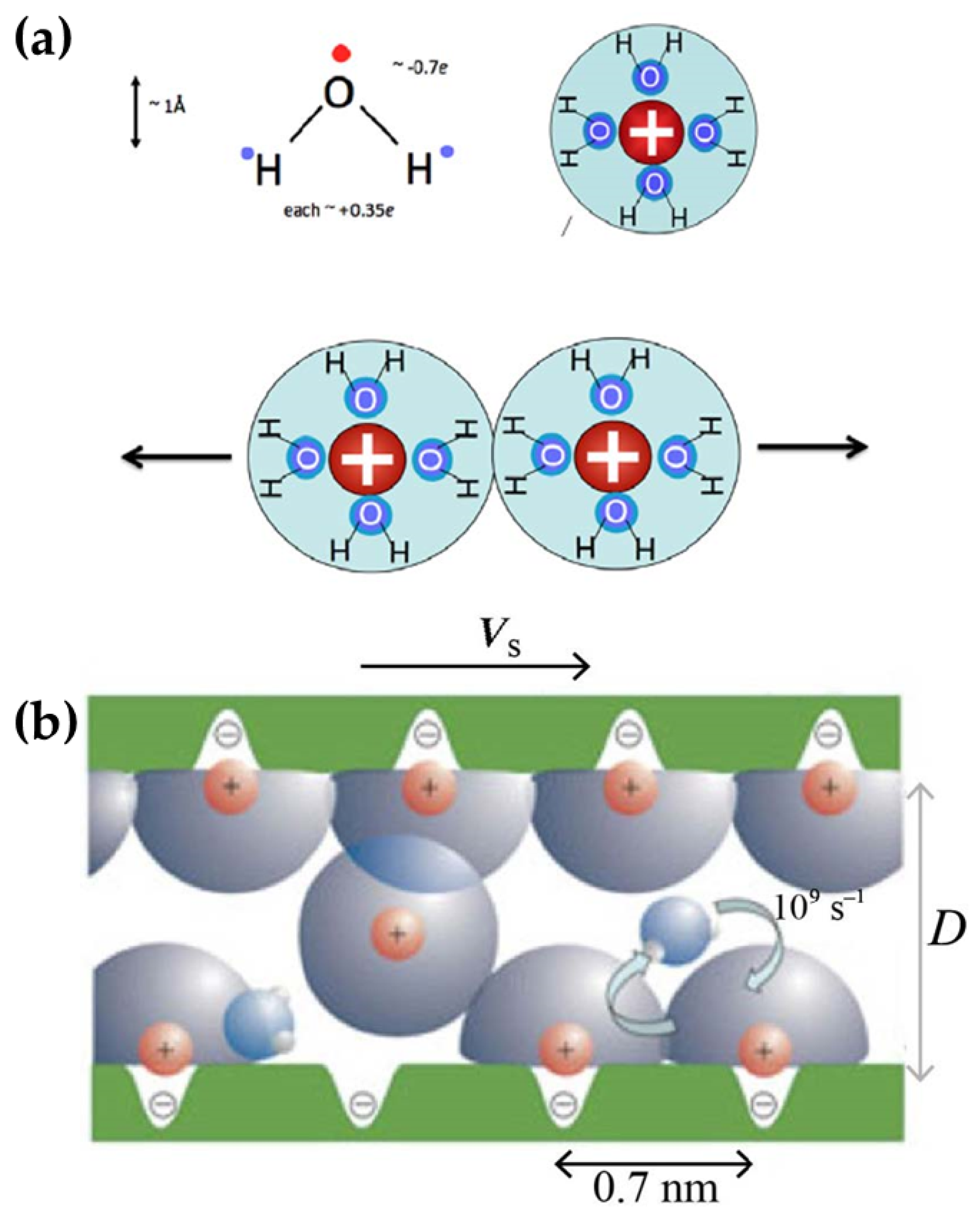
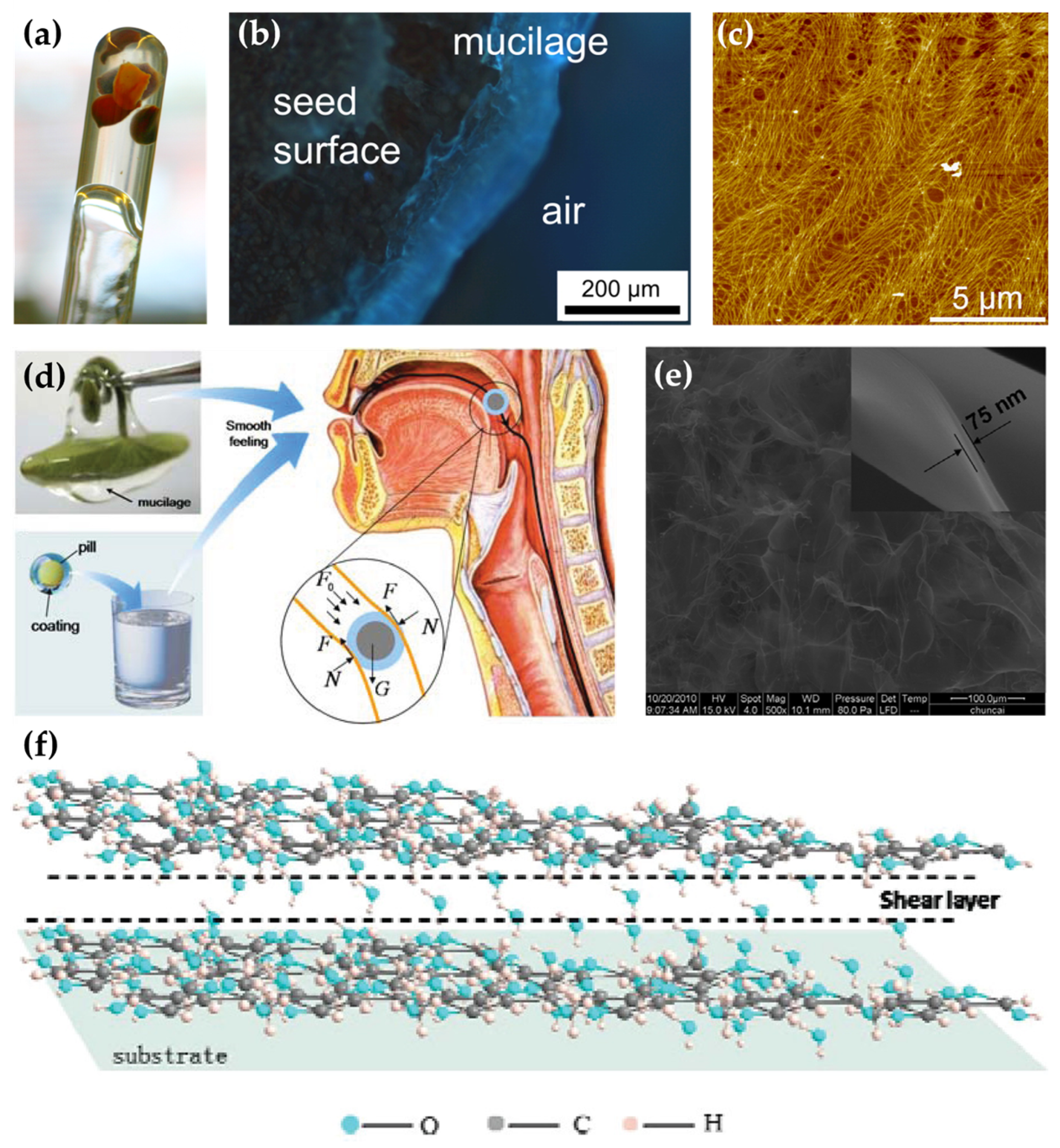
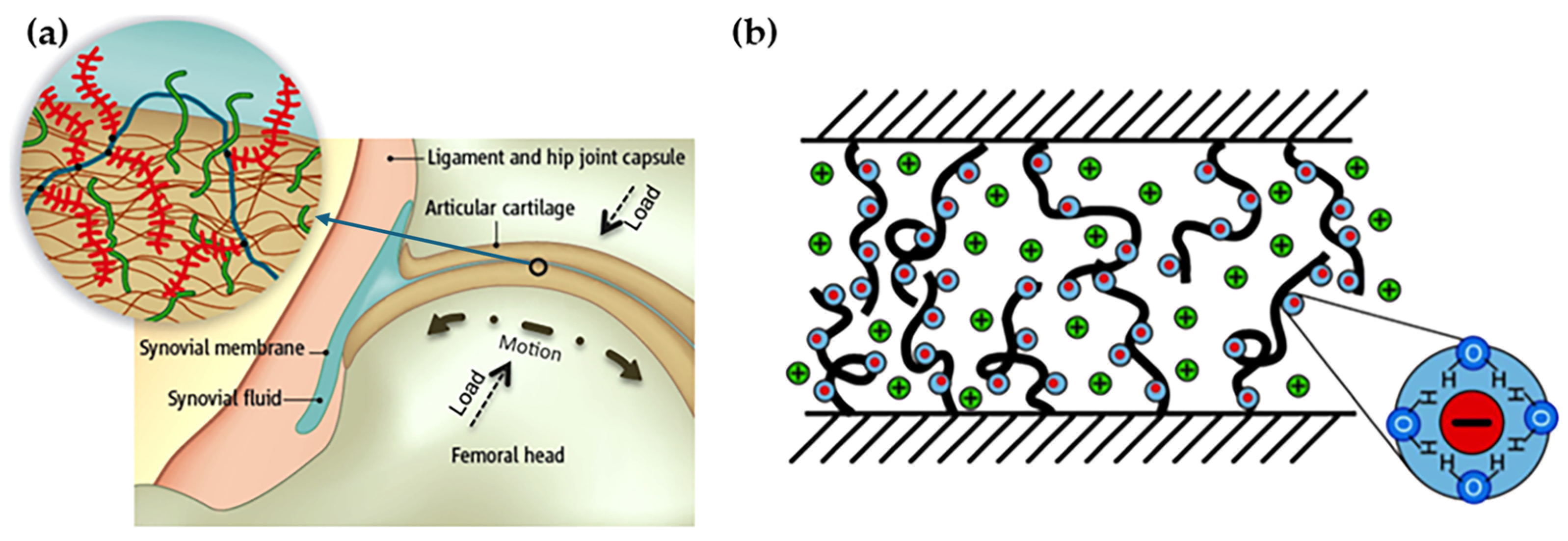
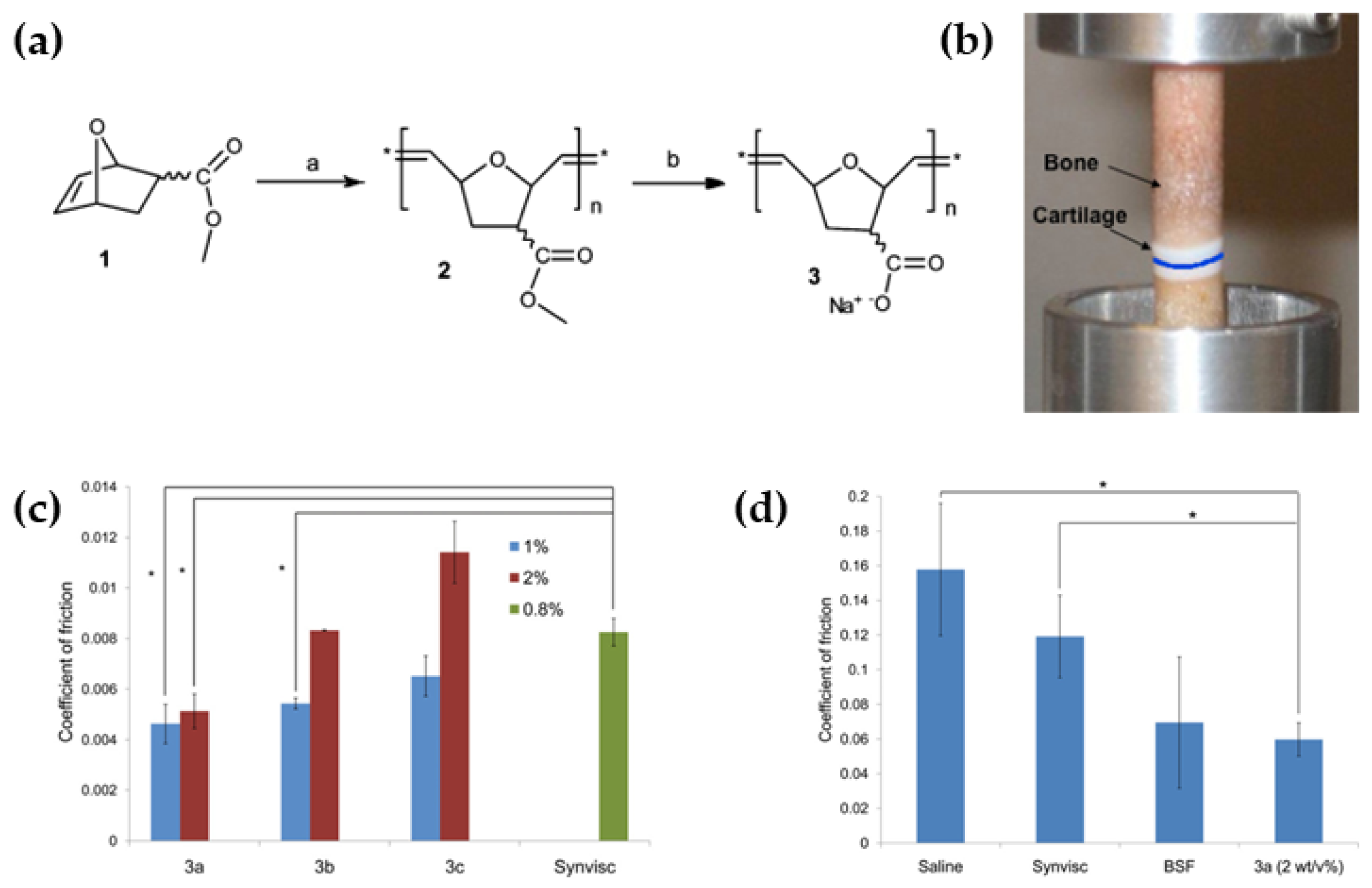


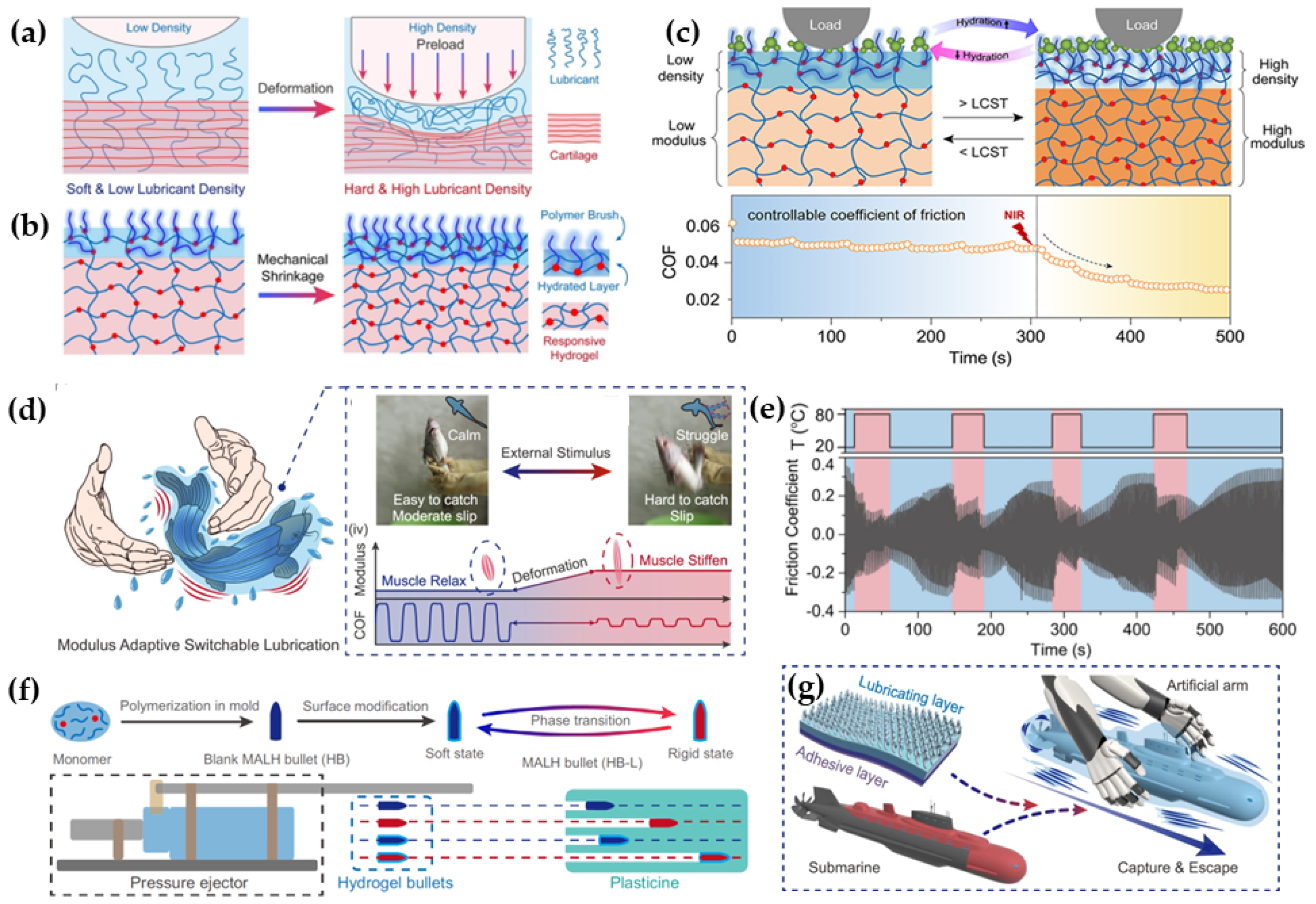

| Creature/Tissue | Friction Substitutes and Velocity | COF | Reference |
|---|---|---|---|
| Aloe mucilage | WC ball/DLC flat; 150 mm·s−1 | 0.04 | [12] |
| Papaya seed mucilage | Polyethylene flat/stainless steel flat; 100 mm·s−1 | 0.03 | [13] |
| Red microalga secretion | Si3N4 ball/alumina flat; 0.2 mm·s−1 | 0.003 | [14] |
| Brasenia mucilage | Glass flat/glass flat; 0.01 mm·s−1 | 0.005 | [15] |
Disclaimer/Publisher’s Note: The statements, opinions and data contained in all publications are solely those of the individual author(s) and contributor(s) and not of MDPI and/or the editor(s). MDPI and/or the editor(s) disclaim responsibility for any injury to people or property resulting from any ideas, methods, instructions or products referred to in the content. |
© 2024 by the authors. Licensee MDPI, Basel, Switzerland. This article is an open access article distributed under the terms and conditions of the Creative Commons Attribution (CC BY) license (https://creativecommons.org/licenses/by/4.0/).
Share and Cite
Kong, Y.; Ma, S.; Zhou, F. Bioinspired Interfacial Friction Control: From Chemistry to Structures to Mechanics. Biomimetics 2024, 9, 200. https://doi.org/10.3390/biomimetics9040200
Kong Y, Ma S, Zhou F. Bioinspired Interfacial Friction Control: From Chemistry to Structures to Mechanics. Biomimetics. 2024; 9(4):200. https://doi.org/10.3390/biomimetics9040200
Chicago/Turabian StyleKong, Yunsong, Shuanhong Ma, and Feng Zhou. 2024. "Bioinspired Interfacial Friction Control: From Chemistry to Structures to Mechanics" Biomimetics 9, no. 4: 200. https://doi.org/10.3390/biomimetics9040200






